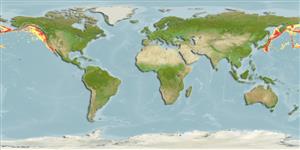>
Gadiformes (Cods) >
Macrouridae (Grenadiers or rattails)
Etymology: Coryphaenoides: Greek, koryphaina = dolphin fish + Suffix oides = similar to (Ref. 45335); acrolepis: From the Greek 'acros' meaning sharp and 'lepis' meaning scale (Ref. 6885).
More on author: Bean.
Environment: milieu / climate zone / depth range / distribution range
Écologie
marin bathydémersal; non migrateur; profondeur 300 - 3700 m (Ref. 50550), usually 900 - 1300 m (Ref. 56476). Deep-water; 1°C - 4°C (Ref. 1371); 62°N - 28°N, 134°E - 115°W (Ref. 1371)
North Pacific: northern Japan to Okhotsk and Bering seas, south along North American coasts to northern Mexico.
Length at first maturity / Taille / Poids / Âge
Maturity: Lm 55.5, range 46 - 65 cm
Max length : 104 cm TL mâle / non sexé; (Ref. 56527); common length : 46.9 cm TL mâle / non sexé; (Ref. 56476); poids max. publié: 3.0 kg (Ref. 56476); âge max. reporté: 73 années (Ref. 35883)
Description synthétique
Morphologie | Morphométrie
Épines dorsales (Total): 2; Rayons mous dorsaux (Total): 122; Épines anales 0; Rayons mous anaux: 94. Head large, scaled completely except for a narrow ventrolateral strip on snout; eyes also large; snout short, pointed and with tubercular scales along its leading edge; chin with a small chin barbel. Body tapering to a point posteriorly from behind the insertion of the first dorsal-fin spine. Scales adherent, with 3 to 5 divergent rows of coarse spinules. Pyloric caeca 12 to 14. Overall color is gray to grayish-brown in young, turning to dark brown in adults; fins generally dark. Branchiostegal rays: 6-6 (Ref. 36385).
A benthopelagic mid-slope species, that appears to wander off slope bottoms into midwater (Ref. 1371). Adults feed on small fish, euphausiids, prawns, amphipods and cephalopods (Ref. 1371). Oviparous, with planktonic larvae (Ref. 36385).
Cohen, D.M., T. Inada, T. Iwamoto and N. Scialabba, 1990. FAO species catalogue. Vol. 10. Gadiform fishes of the world (Order Gadiformes). An annotated and illustrated catalogue of cods, hakes, grenadiers and other gadiform fishes known to date. FAO Fish. Synop. 125(10). Rome: FAO. 442 p. (Ref. 1371)
Statut dans la liste rouge de l'IUCN (Ref. 130435)
Menace pour l'homme
Harmless
Utilisations par l'homme
Pêcheries: commercial
Plus d'informations
RéférencesAquacultureProfil d'aquacultureSouchesGénétiqueElectrophoresesHéritabilitéPathologiesTraitementNutrientsMass conversion
Outils
Articles particuliers
Télécharger en XML
Sources Internet
Estimates based on models
Preferred temperature (Ref.
123201): 2.3 - 3.8, mean 2.4 °C (based on 174 cells).
Phylogenetic diversity index (Ref.
82804): PD
50 = 0.5000 [Uniqueness, from 0.5 = low to 2.0 = high].
Bayesian length-weight: a=0.00141 (0.00085 - 0.00234), b=3.19 (3.04 - 3.34), in cm total length, based on LWR estimates for this species & (Sub)family-body (Ref.
93245).
Niveau trophique (Ref.
69278): 3.8 ±0.54 se; based on food items.
Generation time: 45.8 ( na - na) years. Estimated as median ln(3)/K based on 2
growth studies.
Résilience (Ref.
120179): Très faible, temps minimum de doublement de population supérieur à 14 ans (K=0.02-0.04; tmax=73).
Fishing Vulnerability (Ref.
59153): Very high vulnerability (79 of 100).
Nutrients (Ref.
124155): Calcium = 11.1 [5.3, 31.5] mg/100g; Iron = 0.291 [0.136, 0.661] mg/100g; Protein = 16.4 [14.6, 18.1] %; Omega3 = 0.203 [0.082, 0.497] g/100g; Selenium = 33.6 [11.1, 135.0] μg/100g; VitaminA = 9.83 [1.59, 61.63] μg/100g; Zinc = 0.42 [0.24, 0.75] mg/100g (wet weight);
